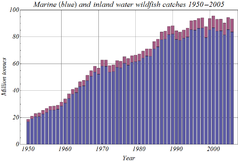- Fishing industry
-
 Modern Spanish tuna purse seiner in the Seychelles Islands
Modern Spanish tuna purse seiner in the Seychelles Islands
The fishing industry includes any industry or activity concerned with taking, culturing, processing, preserving, storing, transporting, marketing or selling fish or fish products.
It is defined by the FAO as including recreational, subsistence and commercial fishing, and the harvesting, processing, and marketing sectors.[1] The commercial activity is aimed at the delivery of fish and other seafood products for human consumption or as input factors in other industrial processes. Directly or indirectly, the livelihood of over 500 million people in developing countries depends on fisheries and aquaculture.[2]
Contents
Sectors
wild marine pelagic predator forage demersal farmed tilapia
Commercially important finfish fisheries There are three principal industry sectors:[3]
- The commercial sector: comprises enterprises and individuals associated with wild-catch or aquaculture resources and the various transformations of those resources into products for sale. It is also referred to as the "seafood industry", although non-food items such as pearls are included among its products.
- The traditional sector: comprises enterprises and individuals associated with fisheries resources from which aboriginal people derive products in accordance with their traditions.
- The recreational sector: comprises enterprises and individuals associated for the purpose of recreation, sport or sustenance with fisheries resources from which products are derived that are not for sale.
Commercial sector
The commercial sector of the fishing industry comprises the following chain:
- Commercial fishing and fish farming which produce the fish
- Fish processing which produce the fish products
- Marketing of the fish products
World production
Main articles: World fish production and Fishing industry by countryFish are harvested by commercial fishing and aquaculture.
According to the Food and Agriculture Organization (FAO), the world harvest in 2005 consisted of 93.3 million tonnes captured by commercial fishing in wild fisheries, plus 48.1 million tonnes produced by fish farms. In addition, 1.3 million tons of aquatic plants (seaweed etc.) were captured in wild fisheries and 14.8 million tons were produced by aquaculture.[4]
Following is a table of the 2005 world fishing industry harvest in tonnes by capture and by aquaculture.[4]
Capture Aquaculture Total Fish, crustaceans, molluscs, etc. 93,253,346 48,149,792 141,403,138 Aquatic plants 1,305,803 14,789,972 16,095,775 Total 94,559,149 62,939,764 157,498,913 This equates to about 24.4 kilograms a year for the average person on Earth.
Commercial fishing
Main article: Commercial fishingThe top producing countries were, in order, the People's Republic of China (excluding Hong Kong and Taiwan), Peru, Japan, the United States, Chile, Indonesia, Russia, India, Thailand, Norway and Iceland. Those countries accounted for more than half of the world's production; China alone accounted for a third of the world's production.
Fish farming
Main articles: Aquaculture, Mariculture, and Fish farmAquaculture is the cultivation of aquatic organisms. Unlike fishing, aquaculture, also known as aquafarming, is the cultivation of aquatic populations under controlled conditions.[5] Mariculture refers to aquaculture practiced in marine environments. Particular kinds of aquaculture include algaculture (the production of kelp/seaweed and other algae); fish farming; shrimp farming, shellfish farming, and the growing of cultured pearls.
Fish farming involves raising fish commercially in tanks or enclosed pools, usually for food. Fish species raised by fish farms include carp, salmon, tilapia, catfish and cod. Increasing demands on wild fisheries by commercial fishing operations have caused widespread overfishing. Fish farming offers an alternative solution to the increasing market demand for fish and fish protein.
Fish processing
 Tuna under the knife
Tuna under the knife Main article: Fish processing
Main article: Fish processingFish processing is the processing of fish delivered by commercial fisheries and fish farms. The larger fish processing companies have their own fishing fleets and independent fisheries. The products of the industry are usually sold wholesale to grocery chains or to intermediaries.
Fish processing can be subdivided into two categories: fish handling (the initial processing of raw fish) and fish products manufacturing. Aspects of fish processing occur on fishing vessels, fish processing vessels, and at fish processing plants.
Another natural subdivision is into primary processing involved in the filleting and freezing of fresh fish for onward distribution to fresh fish retail and catering outlets, and the secondary processing that produces chilled, frozen and canned products for the retail and catering trades.[6]
Fish products
Main article: Fish productsFisheries are estimated to currently provide 16% of the world population's protein. The flesh of many fish are primarily valued as a source of food; there are many edible species of fish. Other marine life taken as food includes shellfish, crustaceans, sea cucumber, jellyfish and roe.
Fish and other marine life are also be used for many other uses: pearls and mother-of-pearl, sharkskin and rayskin. Sea horses, star fish, sea urchins and sea cucumber are used in traditional Chinese medicine. Tyrian purple is a pigment made from marine snails, sepia is a pigment made from the inky secretions of cuttlefish. Fish glue has long been valued for its use in all manner of products. Isinglass is used for the clarification of wine and beer. Fish emulsion is a fertilizer emulsion that is produced from the fluid remains of fish processed for fish oil and fish meal.
In the industry the term seafood products is often used instead of fish products.
Fish marketing
Main article: Fish marketingFish markets are marketplace used for the trade in and sale of fish and other seafood. They can be dedicated to wholesale trade between fishermen and fish merchants, or to the sale of seafood to individual consumers, or to both. Retail fish markets, a type of wet market, often sell street food as well.
Most shrimps are sold frozen and are marketed in different categories.[7] The live food fish trade is a global system that links fishing communities with markets.
Traditional sector
Main article: Artisan fishingThe traditional fishing industry, or artisan fishing, are terms used to describe small scale commercial or subsistence fishing practises, particularly using traditional techniques such as rod and tackle, arrows and harpoons, throw nets and drag nets, etc. It does not usually cover the concept of fishing for sport, and might be used when talking about the pressures between large scale modern commercial fishing practises and traditional methods, or when aid programs are targeted specifically at fishing at or near subsistence levels.
Recreational sector
See also: Recreational fishingThe recreational fishing industry consists of enterprises such as the manufacture and retailing of fishing tackle and apparel, the payment of license fees to regulatory authorities, fishing books and magazines, the design and building of recreational fishing boats, and the provision of accommodation, fishing boats for charter, and guided fishing adventures.
References
- ^ FAO Fisheries Section: Glossary: Fishing industry. Retrieved 28 May 2008.
- ^ Fisheries and Aquaculture in our Changing Climate Policy brief of the FAO for the UNFCCC COP-15 in Copenhagen, December 2009.
- ^ The wording of the following definitions of the fishing industry are based on those used by the Australian government
- ^ a b FAO: Fisheries and Aquaculture
- ^ American Heritage Definition of Aquaculture
- ^ Royal Society of Edinburgh (2004) Inquiry into the future of the Scottish fishing industry. 128pp.
- ^ "ScienceDirect - Aquaculture : Comparative economics of shrimp farming in Asia". www.sciencedirect.com. http://www.sciencedirect.com/science?_ob=ArticleURL&_udi=B6T4D-3T8P28T-F&_user=10&_rdoc=1&_fmt=&_orig=search&_sort=d&view=c&_acct=C000050221&_version=1&_urlVersion=0&_userid=10&md5=48a8882e385af72d0dbdbacde67a9ebe. Retrieved 2008-03-27.
External links
- FAO Fisheries Information
- World Fishing Today, news from fishing industry
- Fish database (FishBase)
- American Fisheries Society
- NOAA Fisheries Service
- One Fish
- The Sunken Billions: The Economic Justification for Fisheries Reform
Principal commercial fishery species groups Wild Forage fishOther wild fishMolluscs- Sea cucumbers
- Sea urchin
- more...



Farmed Fisheries and fishing topic areas Fisheries 
Fishing - Fisherman
- Artisan fishing
- Fishing villages
- Fishing vessels
- Fishing history
Industrial Recreational Techniques Tackle Locations - Fishing by country
- Fishing villages
- Fishing banks
- Fish ponds
- Marine habitats
- Index of fishing articles
- List of fishing topics by subject
- Fisheries glossary
Categories:
Wikimedia Foundation. 2010.









